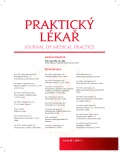The current view of carbon monoxide poisoning in the Czech Republic
Authors:
T. Heřman
Authors‘ workplace:
Vedoucí: prof. MUDr. Leoš Navrátil, CSc., MBA
; Katedra zdravotnických oborů a ochrany obyvatelstva
; Fakulta biomedicínského inženýrství ČVUT v Praze
; Primář: MUDr. Ivo Podpěra
; Interní oddělení
; Oblastní nemocnice Kladno a. s., nemocnice Středočeského kraje
Published in:
Prakt. Lék. 2018; 98(1): 26-30
Category:
Of different specialties
Overview
Carbon monoxide poisoning is the number one in accidental poisoning in Europe and North America. The symptoms are often misdiagnosed and can escape professional as well as non-professional attention. The key prerequisite of early diagnosis is to include carbon monoxide poisoning in our differential diagnosis consideration. The first contact with a patient is often in the hands of the medical rescue service, whose diagnostic opportunities in prehospital emergency care are limited due to the lack of diagnostic methods. These obstacles delay the therapy, which is based on various modalities of oxygen therapy. For more severe cases, we use hyperbaric oxygen therapy, which is operated by the hyperbaric oxygen therapy centres. There are several hyperbaric oxygen therapy centres in the Czech Republic, some of which might not be available 24 hours a day and provide the care for critically ill patients. The article summarizes the mentioned aspects of this issue.
Keywords:
carbon monoxide – hyperbaric oxygen chamber – carboxyhaemoglobin
Sources
1. Clardy FP, Manaker C, Perry H. Carbone monooxide poisoning [on line] 2017. Dostupné na: https://www.uptodate.com/contents/carbon-monoxide-poisoning [cit. 2017-10-13].
2. Masimo Corporation. Detecting carbon monoxide poisoning in the emergency department [on line]. Dostupné na: https://www.physio-control.com/WorkArea/DownloadAsset.aspx?id=2147485313 [cit. 2017-10-13].
3. Dolan MC, Haltom TL, Barrows GH, et al. Carboxyhemoglobin levels in patients with flu-like symptoms. Ann Emerg Med 1987; 16(7): 782–786.
4. Hampson NB, Rudd RA, Hauff NM. Increased long-term mortality among survivors of acute carbon monoxide poisoning. Crit Care Med 2009; 37(6): 1941–1947.
5. Hájek M. Diagnostický a léčebný standard otravy oxidem uhelnatým. Urgentní medicína 2009; 12(1): 19–22.
6. Hájek M. a kol. Hyperbarická medicína. Praha: Mladá fronta 2017.
7. Choi, S. Delayed neurologic sequelae in carbon monoxide intoxication. Arch Neurol 1983; 40(7): 433–435.
8. Buckley NA, Juurlink DN, Isbister G, et al. Hyperbaric oxygen for carbon monoxide poisoning. Cochrane Database Syst Rev 2011; (4): CD002041.
9. Koren G1, Sharav T, Pastuszak A, et al. A multicenter, prospective study of fetal outcome following accidental carbon monoxide poisoning in pregnancy. Reprod Toxicol 1991; 5(5): 397–403.
10. Lopez DM, Weingarten-Arams JS, Singer LP, Conway EE Jr. Relationship between arterial, mixed venous, and internal jugular carboxyhemoglobin concentrations at low, medium, and high concentrations in a piglet model of carbon monoxide toxicity. Crit Care Med 2000; 28(6): 1998–2001.
11. Osladilová L. Intoxikace oxidem uhelnatým v přednemocniční neodkladné péči. Bakalářská práce. Praha: Fakulta biomedicínského inženýrství ČVUT 2017 [online]. Dostupné na: https://dspace.cvut.cz/handle/10467/69088 [cit. 2017-10-22].
12. Šeblová J, Rybáček V, Škulec R, Beer M. Incidence of positive carbon monooxide measurement in prehospital care – prospective epidemiolgical survey 2010. Urgentní medicína 2010; 13(4): 9–11.
13. Touger M, Birnbaum A, Wang J, et al. Performance of the RAD-57 pulse CO-oximeter compared with standard laboratory carboxyhemoglobin measurement. Ann Emerg Med 2010; 56(4): 382–388.
14. Vidunová J, Šin R, Hon Z, Kruba K. Otrava oxidem uhelnatým – stále aktuální problém. Prevence úrazů, otrav a násilí 2013; 9(1): 36–42.
15. Weaver LK, Hopkins RO, Chan KJ, et al. Hyperbaric oxygen for acute carbon monoxide poisoning. N Engl J Med 2002; 347 : 1057–1067
Labels
General practitioner for children and adolescents General practitioner for adultsArticle was published in
General Practitioner

2018 Issue 1
- What Effect Can Be Expected from Limosilactobacillus reuteri in Mucositis and Peri-Implantitis?
- Memantine Eases Daily Life for Patients and Caregivers
- Metamizole vs. Tramadol in Postoperative Analgesia
- Metamizole at a Glance and in Practice – Effective Non-Opioid Analgesic for All Ages
Most read in this issue
- Acute renal failure and acute kidney injury
- Violence and aggression to professionals in healthcare facilities
- The current view of carbon monoxide poisoning in the Czech Republic
- The patient has a family! Individualised care from a systemic perspective
